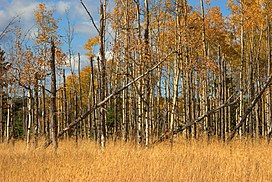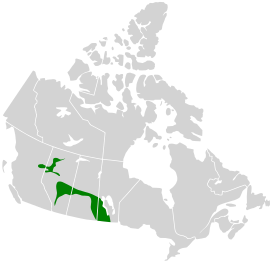Aspen parkland
| Aspen parkland | |
|---|---|
 | |
 Aspen parkland within Canada | |
| Ecology | |
| Realm | Nearctic |
| Biome | Temperate grasslands, savannas, and shrublands |
| Borders | List
|
| Bird species | 206 Humid continental (Dfb) |
| Conservation | |
| Conservation status | Critical/Endangered[2] |
| Habitat loss | 63.76%[1] |
| Protected | 2.95%[1] |
Aspen parkland refers to a very large area of
This article focuses on this biome in North America. Similar biomes also exist in
Definitions
According to the Ecological Framework of Canada, published in 1999, the Aspen Parkland ecoregion (#156) is the largest and northernmost section of Prairies Ecozone.[5] This definition is the arc-shaped region (i.e. including the WWF's central and foothills parkland but excluding the Peace River region). Partly defined by climate, it had a mean annual temperature of approximately 1.5 °C circa 1999, and rainfall varied from 400 to 500 mm/annum. It includes the communities of Red Deer and Edmonton in Alberta; Lloydminster on the Alberta–Saskatchewan border; North Battleford, Saskatoon, Humboldt, and Yorkton in Saskatchewan; and Brandon, Manitoba as its major population centres and have a total population of 1.689 million. By this definition, there are approximately 5,500,000 hectares (14,000,000 acres) of this ecoregion in the province of Alberta.[6]
According to the
Setting
The aspen parkland biome runs in a thin band no wider than 500 km through the
There are three main sections of aspen parkland: Peace River, Central, and Foothills. The Central Parkland is the largest section and is part of main band of aspen parkland extending across
Climate
The region has a
Flora
This section needs additional citations for verification. (January 2017) |

Four significantly different habitats are common in the aspen parklands: The
There are numerous grasses and sedges in the fescue prairie. Gravelly and rocky terrain is a good location for parry oat grass. Dry areas favour June, porcupine and spear grass. Wet areas are often covered with slender wheat grass and timber oat grass. Prairie rose and snowberry are common shrubs found in these grasslands.
The forested, or woodlands area is dominated by trembling aspen (
Aspen woodlands support an extensive understory consisting of mid-sized and small shrubs, some herbs and ground cover. Spruce-dominated woodlands usually do not support a dense understory due to more acidic and nutrient-poor soils and a denser canopy, which reduces sunlight reaching the forest floor below. However, in areas where a mixture of aspen and spruce occur, a fairly dense understory can still thrive. The mixed wood understory, as it is called, supports the greatest diversity of forest wildlife in the aspen parkland.
Large shrubs such as
Wetlands are very common in this biome, including lakes, shallow open water, marshes, and grassy wetlands. Glacial erosion has contributed to such features by creating depressions in which standing water can collect. In the larger depressions, permanent lakes or ponds of water remain. Many of the lakes have a saline character, thus most shore vegetation has a high tolerance of
Rivers and streams erode valleys throughout the parkland ecoregion. Steep hills and ravines result in a unique topography. Southwest slopes with increased exposure to the sun are dry and often more grass covered, while the shaded north and east exposures retain more moisture and tend to have greater forest cover. Some forms of vegetation unique to the ravines include: poplar, spruce, birch, willow, and river alder.
The aspen understory
There are three main factors which influence the understory vegetation in the aspen stands of the mixed wood forest.
1. Good sun exposure encourages a dense vegetation growth below the canopy. This is of particular importance in the early spring before the trees are in leaf.
2. Warm soil and air temperature at the base level result in rapid melting process in spring which favours the growth of shrubs.
3. A large percentage of precipitation passes through the canopy. This provides a protective snow cover in winter and in warm seasons precipitation percolates through the leaf cover to nourish plants which require surface soil moisture.
The result of the above factors is an extensive understory of vegetation in the aspen forest. Common shrubs and herbs are:
The mineral soil is covered by a decaying cover of organic matter. Numerous consumers and decomposers create humus materials. Burrowing animals mix the new fertile materials with the soil to form a rich rooting compound.
The spruce forest understory
Factors which influence the understory vegetation of spruce stands in the
1. Year round reduced sun exposure below the canopy restricts the forest undergrowth to shade tolerant species.
2. A large percentage of the precipitation is trapped in the upper tree boughs of the spruce forest and is released through evaporation. The ground cover of
3. The fallen acidic spruce needles are not fully decomposed and combine with the moss base. Water held in the moss carries the acid from the spruce needles into the mineral soil and leaches out soil nutrients – leaving a highly acidic, low nutrient soil base which is unsuitable for most boreal vegetation.
As a result of the above factors the
The mixedwood stands understory

There are several factors which influence the mixedwood stands in the boreal forest.
Where there are stands of aspen and spruce forests in close association with each other, a mixed wood forest occurs. Each group forms its own microassociation as described previously.
When the spruce and aspen forest types are mixed, the result can be quite different from the aspen or spruce stands. Animal and vegetation associations from each type combine to create considerable diversity of habitat which is typical of either spruce or aspen stands. The mixture of the transition soils provides an attractive environment with either pure spruce or pure aspen woodlands. An example of a bird which prefers a mixed wood habitat is the yellow-rumped warbler.
The mixedwood forest wetlands consist mainly of
For boreal aspen stands less than 40 years old, Comeau (2002)[11] found that basal area provided a useful general predictor of understorey light levels, but, on the basis of light measurements in one 80-year-old stand, cautioned that relationships between understorey light and basal area may not hold in older stands. The literature indicates that the height growth of understorey spruce should be maximized when light levels exceed 40% or when aspen basal area is less than 14 m2/ha. Models developed by Wright and others in 1998 show radial growth of understorey white spruce increasing almost linearly with increasing light and a continuous decline in radial increment with increasing aspen basal area.[12] When applied to Comeau's 2002 data,[11] the Wright models suggest that spruce mortality will remain very low until aspen basal area exceeds 20 m2/ha, above which mortality will increase rapidly.
Fauna

Wildlife in the parklands include
Burrowing rodents such as Richardson's ground squirrels, thirteen-lined ground squirrels, and pocket gophers play a major role in the balance between the aspen groves and the grassland. These excavators make mounds of fresh soil which are ideal locations for the germination of poplar seeds. Once established, these trees spread by suckering, thus creating a new aspen groves.
White-tailed deer finds shelter in the aspen and graze on the grasslands; coyotes and foxes hunt the resident rodents. Historically, bison grazed on the grassland and helped to prevent the spread of aspen groves. However, bison are now mostly absent due to over hunting during settlement in the 19th century and extensive loss of habitat due to agriculture. Bison, however, can still be seen in protected areas such as Elk Island National Park east of Edmonton and in farms, where they are raised for meat. Boreal woodland caribou (Rangifer tarandus caribou) also used to roam the Parkland, especially the Peace region, but were hunted out of the area.
Wildlife in the woodlands is varied and abundant. The varying hare, weasel, fox, coyote, and white-tailed deer make their homes in this region, while water dependent mammals who make the ravines and wetland areas of the ecoregion their home are beaver, muskrats, otters and mink.
Birds of the aspen parkland include kingfishers, ruffed grouse, magpies and northern orioles. and in particular several species of warblers find this a preferred habitat.
Extensive cultivation has disturbed the habitats of some birds which nest and feed on the fescue grassland. However, the horned lark and meadowlark have managed to adapt to the new conditions. Song sparrow, vesper sparrow, and American goldfinch can often be seen in open areas.
The woodlands meanwhile are abundant with a variety of bird species. Black-capped chickadee, hairy woodpeckers, ruffed grouse, magpies, and great horned owls can be observed in all seasons. Summer residents include: red-eyed vireo, least flycatcher and northern oriole.
Birds which prefer the wetland habitat include
The invertebrate population in the woodland is enormous. Some of the most common invertebrates are roundworms, snails, segmented worms, centipedes, mites, spiders and mosquitoes.
Human use, threats and conservation


Before European colonization, there were large areas of western aspen and aspen parkland in the west of what would become Canada and the United States. This was maintained by light to moderate fires with a frequency of 3 to 15 years. Fire also swept the Rocky Mountains aspen as frequently as every ten years, creating large areas of parkland. Settlement increased fire frequency in the late 19th century until fire suppression became popular.[13]
Most of the aspen parkland, like the
The largest blocks of intact parkland can be found in
Human cultures
The First Nations of this region were not solely
This area was one of the most important regions of the
Once European settlement began, this region was desired by the peasant farmers of
As a result of these different styles of indigenous hunting agricultural settlement, the ethnic makeup of the
See also
References
- ^ a b c d
Hoekstra, J. M.; Molnar, J. L.; Jennings, M.; Revenga, C.; Spalding, M. D.; Boucher, T. M.; Robertson, J. C.; Heibel, T. J.; Ellison, K. (2010). Molnar, J. L. (ed.). The Atlas of Global Conservation: Changes, Challenges, and Opportunits to Make a Difference. ISBN 978-0-520-26256-0.
- ^ a b c "Canadian Aspen forests and parklands". WWF. World Wildlife Foundation. Retrieved 14 May 2016.
- ^ "Tallgrass Aspen Parklands Province".
- ISBN 0-8020-7995-4. Retrieved 2016-05-14.
- ^ "Prairies Ecozone".
- ^ "Agriculture and Forestry".
- ^ "Canadian Aspen forests and parklands | Ecoregions | WWF".
- ^ "Alberta's Parkland Region". raysweb.net. Retrieved 2016-05-14.
- ^ "Parks Canada - Waterton Lakes National Park - Green Scene - From Bottom To Top". Pc.gc.ca. 2013-01-23. Retrieved 2016-05-14.
- ^ "Tallgrass Aspen Parkland Biome". Minnesota Department of Natural Resources. Retrieved 2022-09-19.
- ^ a b Comeau, P. G. (2002). "Relationships between stand parameters and understory light in boreal aspen stands". B.C. Journal of Ecosystems and Management. 1 (2).
- doi:10.1139/x98-055.
- doi:10.2737/RMRS-GTR-42-V2. Archived from the originalon 2017-07-05. Retrieved 2008-07-20.
External links
- "Canadian Aspen forests and parklands". Terrestrial Ecoregions. World Wildlife Fund.
- Canadian Aspen forests and parklands (Vanderbilt University)
